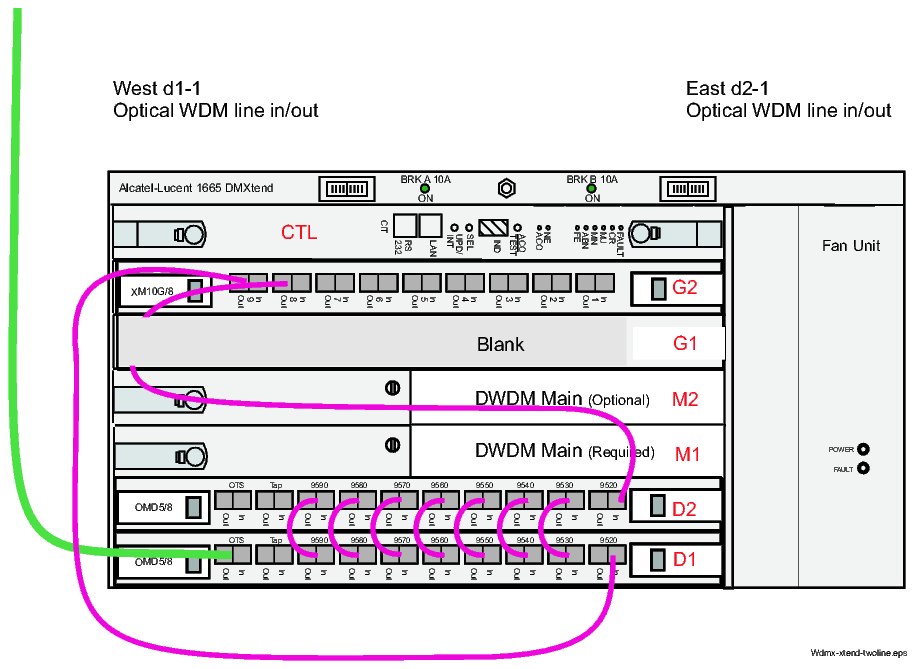WDMX via Alcatel-Lucent 1850 Transport Service Switch product family
Overview
Alcatel-Lucent 1665 DMXtend offers WDM optical transmitters for main optical packs and also offers non-integrated mux/demux, optical amplification and transponders through the Wavelength Extension Services (WES) portfolio. WDMX is the integration of these types of WDM functions directly on the Alcatel-Lucent 1665 DMXtend shelf platform. It provides metro transport markets with a state of the art low-cost converged MSPP/MSTP solution for both TDM and WDM. The LNW705 circuit packs support this integration on Alcatel-Lucent 1665 DMXtend.
WDMX comprises feature sets that add the ITU-T Optical Transport Network (OTN) layered structure for WDM within the Alcatel-Lucent 1665 DMXtend shelf footprint. The optical transport network layered structure consists of optical channel, optical multiplex section and optical transmission section. Pre-existing Alcatel-Lucent 1665 DMXtend WDM interfaces may also be directly connected to the optical multiplex section without using the ITU defined optical channel encapsulation.
WDMX channel wavelengths
The WDMX channel wavelengths are based on the industry standard ITU-T grid at 100 GHz spacing in the Cband. The lowest frequency is 195200 GHz and the highest is 195900 GHz. The channels are generally described using only the middle four digits. For example, ITU-T channel 55 is at frequency 195500 GHz. Some device labeling only uses middle 2 digits. For example, 195500 GHz could also be represented on device labeling as frequency “55”. These 8 channels overlap with the 32 channel wavelength plan of the Wavelength Extension Solutions (WES) product, and 6 of the 32 channel wavelength plan of the EON system. (EON uses ITU-T 52 - 57 in common with WDMX.) WDMX does NOT offer optical amplification through the use of the WES optical amplifier shelf.
The optical components of WDMX are optimized for transport of XFP based 10G transmitter for metro access and metro core applications. This optimization allows for lower cost of WDMX and allows for better interoperability with the alien wavelengths expected in the metro access and metro core.
Applications
WDMX is designed for application by service providers in metro access, metro core, and extended metro deployments, as well as high capacity enterprise and campus networks.
Triple play applications
Alcatel-Lucent 1665 DMXtend provides a great solution to the low cost Triple Play (voice, video and data) distribution application focusing on data rates below OC-48.
Service providers are dealing with the problem of enhancing video distribution and Ethernet broadcast distribution and making it affordable. WDMX is perfectly matched to meet a major portion of that need.
Some customers have a requirement for full C-band tunable lasers and very long reach without regeneration for their video backbone networks. Although WDMX is not intended as a full range multi-haul system, it can lead to dramatic savings for the service provider. WDMX is expected to be the first system to focus the latest full set of optimized technologies for metro deployments.
Video applications typically have a two tiered network. One tier consists of national video broadcast feeds through a national core network into local Video Broadcast (VBC) and Video-On-Demand (VoD) servers at the regional and local Video Hub Offices (VHO). The second tier connects the VHOs with Video Service Offices (VSO). The VSO distributes the multicast VBC paths and manages the unicast connections for VoD paths.An Ethernet Aggregation Router collects and distributes traffic to and from DSLAMs and routers in the access network.
The typical VSO will house 2 Edge Aggregation Routers (EARS). Each of the EARs will interface to:
This is a total of 6 to 9 GbE. So, most VSOs will require less than 8 wavelengths. However, the VHOs and Optical hubs will require more than 8 wavelengths.
MSPP exhaust applications
There are cases where there is a large jump in high bandwidth service demands along the path of an existing MSPP ring. If such services are projected to exceed the ring capacity (capacity exhaust), WDMX can be used. Alcatel-Lucent 1665 DMXtend R5.1.1 allows an existing partially filled shelf to add 10G wavelengths for client interfaces with data rates of OC-48 or below. The wavelengths added are passed transparently, which is critical to applications that would lose proprietary functionality if the client signals attempted to use standard section and line termination of SONET for transport.
Large data center/SAN high availability applications
The substantial disasters of the last ten years have caused both industry and the government to require geographical redundancy of mission critical data in real-time or near real-time to assure high availability. This requires substantial high capacity transport of Ethernet and Fibre Channel data for Fortune 1000 Enterprises.
WDMX optical multiplexing network models
A WDM line (OTS) is a bidirectional multicolored composite optical line, up to two per Alcatel-Lucent 1665 DMXtend shelf. WDM Lines (OTS) are the entities that connect WDM systems into networks. If only one WDM Line is used, the system is referred to as an end terminal and can be used in point to point networks or at the end of chain of ring nodes. Two lines are required for optical add/drop multiplexers (OADMs) used as rings, nodes, and in linear chains: one line faces West (slot 1 of an OMD [LNW785] pack pair, e.g., d1-ots), and the other line faces East (slot 2 of an OMD [LNW785] pack pair, e.g., d2-ots).
The following network examples illustrate various arrangements of end- terminals and add/drop ring nodes that can be used for WDMX. In the following examples, a single line represents two-fiber connections between NEs.
Point-to-point/end-terminal-to-end-terminal
This simple configuration can provide extra wavelengths between two points.
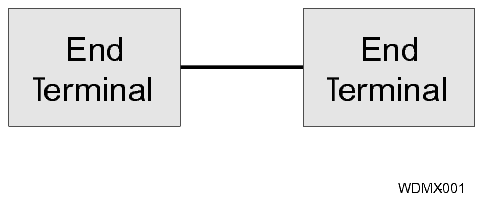
Terminated ring
The terminated ring configuration can provide extra wavelengths between three or more points, terminating back at the single end-terminal.
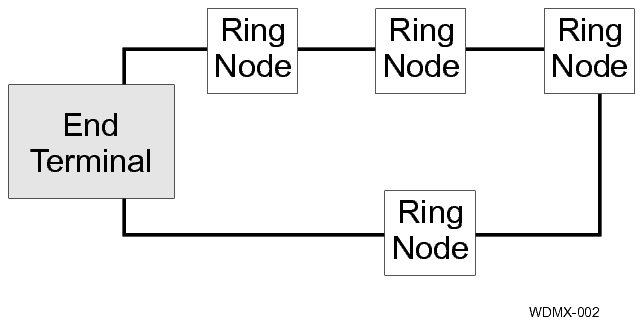
Linear chain
This is expected to be the most common use of WDMX to get extra wavelengths between three or more points in the network for traffic demands that tend to emanate and terminate at two central points in the network. For this approach the traffic from the OADMs is expected to be dual feed to each end-terminal. Some IPTV applications may use this network approach.

Double-terminated ring
The double terminated ring is also expected to be very a common topology. It is composed of two EAR rings, joined at the end-terminals. The End terminals typically are the hubbing locations that sync and source the traffic. The Ring nodes typically allow relatively small counts of wavelengths to enter the network and send it in diversely routed directions toward independent end-terminals. This allows for the protection of services.
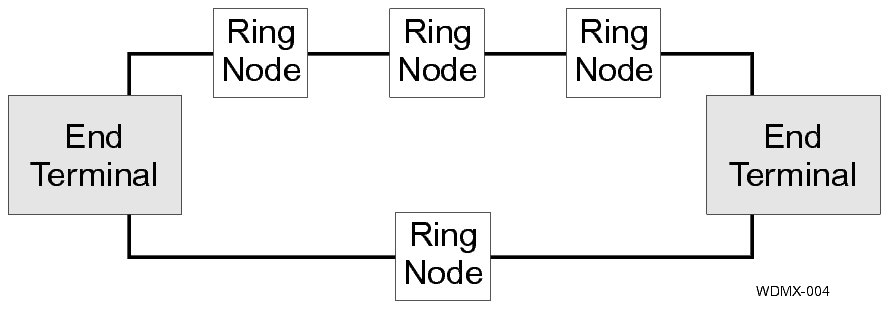
Pure ring
Pure rings contain no end-terminals, and allow any traffic mix between the ring nodes. This arrangement provides greater flexibility. However, care must be taken to assure optical noise loops (lasing) are not created. This is accomplished by creating high attenuation on pass-throughs for all optical channels that are not equipped.
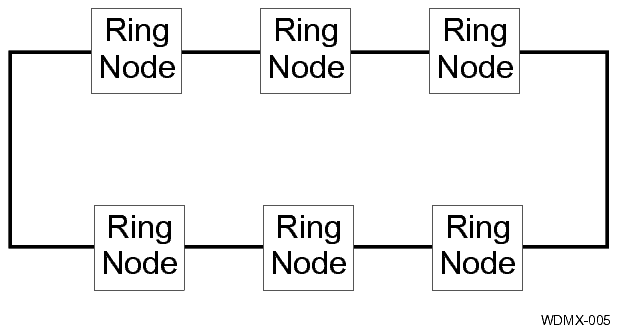
WDMX shelf models
WDMX can be implemented by using spare slots in existing Alcatel-Lucent 1665 DMXtend SONET shelves that already make use of the main slots, and a subset of the function unit and growth slots. For these applications, WDMX is a WDM overlay on top of the existing SONET applications.
Multi-service transport over OTU-2
With the LNW705 muxponder pack, WDMX can be used without requiring SONET application packs in the shelf. Main packs are required for system timing. The LNW705 XM10G/8 Muxponder circuit pack is a highly integrated pack that multiplexes up to 8 ports of the most common high bandwidth client interfaces onto a single 10G wavelength. The 8 client ports can be a mix of the following signals: 1GE, FC100, FICON, FC200, FICON_EXP, 1000BASE-ZX, or OC3/12/48. One GE is mapped using VCAT and GFP-F. All FC signals and FICON signals are mapped using VCAT and GFP-T. The client signals are mapped into a single STS-192 and then encoded into an OTN OTU-2 signal (including forward error correction) and is transmitted out on a DWDM XFP. The circuit pack is bi-directional and simultaneously handles the inverse function in the receive direction.
Figure 3-17: LNW705 ports
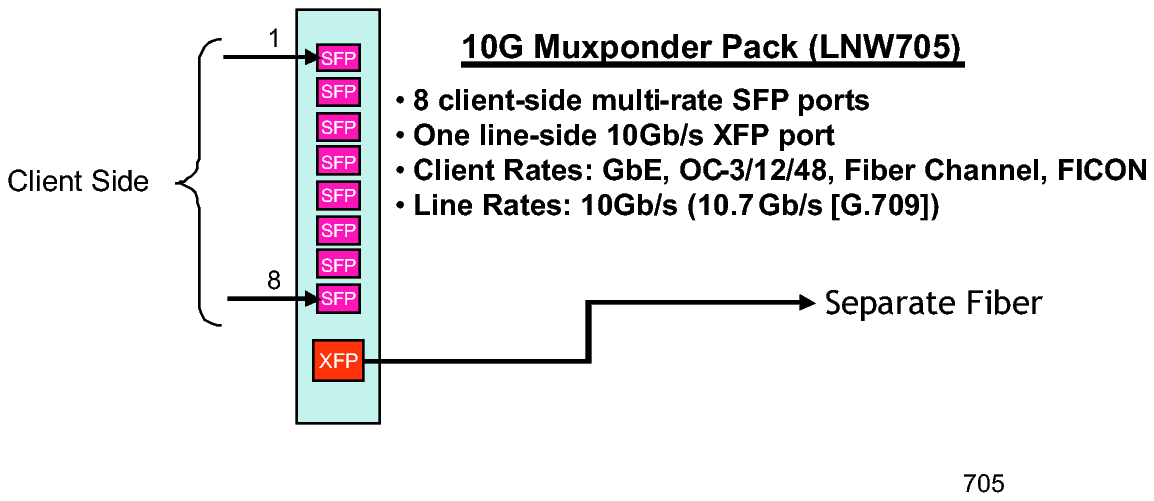
Figure 3-18: WDMX with LNW705 packs
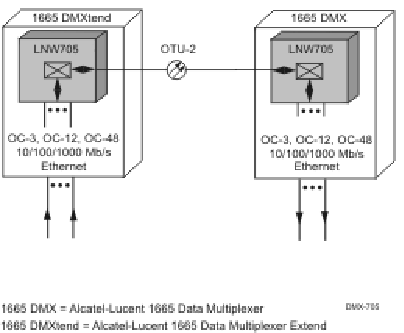
In the figure, multiple client signals are coming into the LNW705 on the Alcatel-Lucent 1665 DMXtend. The LNW705 multiplexes up to 8 client ports onto the single OTU-2 for transport over the fiber. The LNW705 in the Alcatel-Lucent 1665 DMX demuliplexes the signals and sends them onto another NE.
One-line unamplified 8 channel end terminal node
This model consists of a Alcatel-Lucent 1665 DMXtend shelf, shelf controller, 1 or 2 main packs for shelf timing, an 8 channel OMD pack (LNW785), and the following, optionally directly connected to the OMD:
The OMD pack (LNW785) may be equipped in any unequipped function or growth slot. OSMINE supported models for Alcatel-Lucent 1665 DMXtend allow function groups D and the growth slots. (The growth slots on Alcatel-Lucent 1665 DMXtend are side by side.)
A one-line 8 channel end terminal can have 1 or 2 main packs, 1 LNW2 controller, 1 WDM line, 8 optical channels, and 64 client ports in a single shelf.
Figure 3-19: WDMX 1-line end terminal
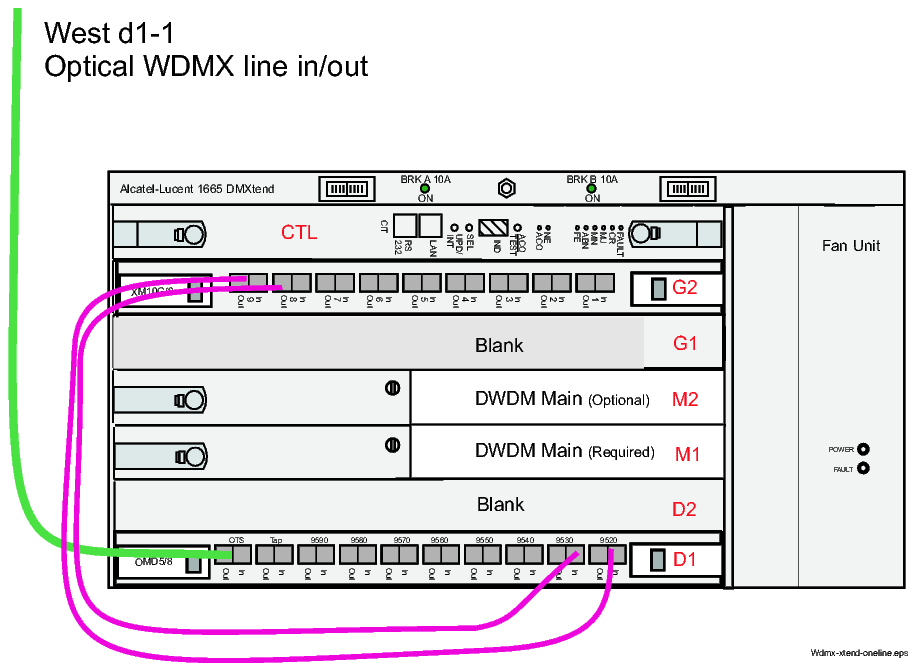
Two-line unamplified 8 channel add-drop ring node
This model consists of a Alcatel-Lucent 1665 DMXtend shelf, shelf controller, 1 or 2 main packs, one 8 channel OMD pack (LNW785), and directly connected to each OMD one or more of the following:
-
Existing packs and functions with the interconnect to the OMD pack typically equipped in the Main slots
The OMD packs may be equipped in pairs in any unequipped function slot pair A, B, C or D in Alcatel-Lucent 1665 DMX and slots pairs D and Growth in Alcatel-Lucent 1665 DMXtend. A two line 8 channel end terminal can have: 2 WDM lines, 16 optical channels, and 64 client ports in a single shelf. It can be used in conjunction with more shelves or alien wavelengths to connect the 8 optical channels that exceed the capacity of a single shelf.
Figure 3-20: WDMX 2-line add/drop ring node
